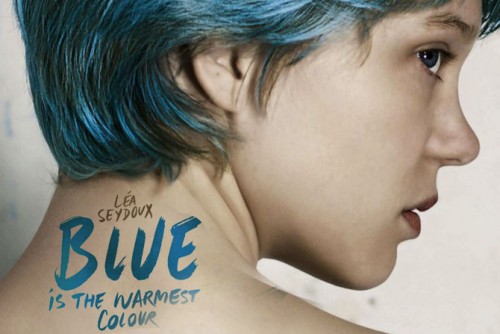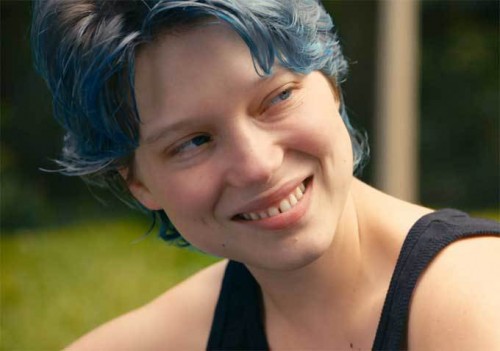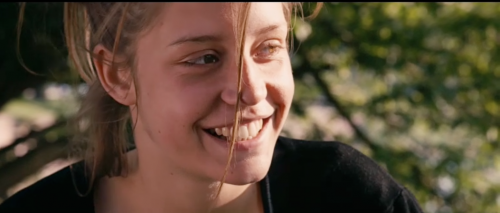
This is a guest post by Ren Jender.
A three-hour art film about two queer women with subtitles is like a dream come true for me: I’ve sat through arty, subtitled films twice that long–which didn’t have a trace of queer content. So I’ve obsessively read everything I can about Blue Is The Warmest Color. And I’m puzzled. In an age when writers of color like Wesley Morris and Roxane Gay bring added perspective and insight to their reviews of films like, Django Unchained and 12 Years A Slave, why are straight men the overwhelming majority of people telling the world whether or not the sex scenes in Blue are convincing?
I saw the film about five months after it had won the top prize at Cannes (in an unusual move the jury awarded the prize to the two stars, Léa Seydoux and Adèle Exarchopoulos, as well as the director, Abdellatif Kechiche) just prior to its US release. Julie Maroh (the queer author of the original graphic novel on which the film is based) prepared me to not love the sex scenes, which she described as “porn,” ” brutal and surgical,” and “cold.”
What I didn’t expect, in a film that is told almost entirely in close-ups on faces, was the director (who also co-wrote the script) framing the sex scenes so they have as much tits and ass–especially ass–in them as possible. The actresses (Seydoux as Emma and Exarchopoulos as Adèle: the director named the main character and the film itself–the French title is La vie d’Adèle—after the woman playing the lead) do a beautiful job of making us believe in this romance–during the rest of the film. But here they are stuck playing a joyless game of naked Twister. We can practically hear the director shout, “Put your hand there! Put your face there! No, there! Now slap her ass! Again!” The ass slapping reminded me of the moment in male-directed, girl-on-girl porn clips, in which, to keep the audience from getting bored and give the actresses something to do, one woman is directed to slap (or tap: it makes a noise like slapping) the vulva of the other woman–even though: I don’t want my vulva slapped, and I’ve never met another queer woman who wants her vulva slapped nor one who gets pleasure from slapping the vulva of another woman.
The director frames a scene in a museum much like the sex scenes, so we get an eyeful of the breasts and buttocks from the nude artworks, as if the scene takes place at a peepshow. If the director had been able to stop ogling women’s body parts, he could have redeemed himself. A woman (who has never had sex with another woman) seeing nudes in the company of the woman to whom she has a strong sexual attraction is a situation rife with possibility. And part of what makes Adèle and Emma’s bond believable is the instant and electrifying attraction they have to each other: Adèle literally stops traffic when she first sees Emma and fantasizes about her that night, though the two haven’t even spoken. Every other moment of their relationship feels genuine (except when one woman hits the other during a fight, which also feels like a man’s version of what two women do when they’re alone), so we feel cheated during the naked sex scenes.
We see what the nude scenes could have been later in the film when the characters have a sexual moment but stay fully clothed–which is maybe why the director doesn’t ruin the mood. The camera focuses on their faces and the emotion that plays across them. Perhaps Kechiche finally learned that no one is able to act with her ass.
Besides being a creep, Kechiche is an asshole. He cheated his crew out of overtime pay and continued a long tradition of male directors harassing their very young, very naked actresses on the set. When the two women had the temerity to complain, well, you can read for yourself his translated public statements at at Flavorwire. In spite of himself and those ten bad minutes (out of 180), Kechiche’s Blue Is The Warmest Color is a great film everyone should see.
Although the filmmakers (I am including the actresses since, according to all parties, improvisation played a big part in the finished film) and straight reviewers are quick to describe the film as being a universal one of first love, and as Maroh has pointed out no queer women had a prominent role in the creation of the film, it captures queer life and love well, especially the intensity and desperation of a teenager’s first relationship with another woman. When the two have their big fight I cringed in recognition–as I did during many other moments.
The isolation Adèle experiences in her relationship with Emma is nothing like the peer-pressure romance she has at the beginning of the film with the sensitive, good-looking, older boy at school. Her high school friends (most of whom have the same neat, fashionable haircut; Adèle’s hair is messily piled on her head but at the same time always gets in her face) seem more eager about the relationship (“He likes you!”) than Adèle does.
After she breaks up with the boy, we see Adèle walking away from the high school friends who are calling her name to be with Emma. Adèle is opening her life to the elements, to a tornado, knowing nothing will be the same afterward and not caring about the consequences. So we’re not surprised that Adèle clings to Emma like a life preserver. And we’re also not surprised to see that later in the film, without Emma, she starts to sink.
After she’s finished with school, Adèle doesn’t talk with straight coworkers about her personal life, even though she gets along with them and likes her job. She wants to avoid coming out to them. She even hides her true address, so none of them find out she lives with a woman. When heartbreak comes she can’t tell the people she works with why she doesn’t feel like dancing with the preschoolers they look after, so she goes through the motions, letting her real feelings surface only after everyone has left, and the day is done.

Seydoux (whose previous roles are nothing like the one she plays here) makes Emma a beautiful butch, especially in her later scenes in which she seems lit from within, as if she stepped out of a Renoir painting. Emma is an artist herself and so stunning even those of us who are art-snobs can almost forgive her shitty paintings: the director seems to know as much about the art world as he does about sex between women.
Even in the mainstream films queer women love, we usually have to ignore the discrepancy between how non-character actresses in mainstream films are supposed to look and how butches look. Popular films will sometimes feature a butch who wears makeup heavy enough to be visible on camera, or we will see a woman who is supposed to be butch who has obvious breast implants. Though individual butches may have these attributes, they don’t signal “butch” to other queer women, including those in a film audience.
With her pale lashes and unpainted mouth Seydoux is one of the most recognizable butches I’ve seen in any movie, including those made by queer women. And her Emma pleasantly surprises us in the way that people in real life sometimes surprise us. We expect flirtatious, teasing, older Emma, who has her arm around another woman when she first sees Adèle, and a posse of admirers at the women’s bar, to break Adèle’s heart, but Emma turns out to be a serial monogamist who genuinely cares about Adèle. When Adèle first sees the inevitable cracks forming in her relationship with Emma she does the one thing guaranteed to destroy it (without consciously admitting what she is doing). Adèle ends up breaking her own heart.
Seeing the two actresses play the scene in the café toward the end is like watching two great musicians play together. Some viewers have complained the film is too long, but Blue takes time to unwind the way relationships take time, the way heartbreak takes time, the way life takes time. Even at three hours we just want more.
The film also excels in capturing the experiences of queer women who are femmes. At one point, we see Adèle (who wears skirts and heels) cook for, serve and then clean up for a large group of people she barely knows while her butch girlfriend (whose friends are the party guests) literally lies back with her hands under her head. I’ve played a similar “wife” role to a butch partner–and seen too many other femmes I know do so too.
In a long scene at the party, a man corners Adèle into a conversation about her sexuality, his eyes glittering (he could be a stand-in for the director!), and she’s too polite to tell him to fuck off. I’ve been to that party, met that man, and been that woman.

Adèle is beautiful in the conventional sense (with her hair down, she resembles a younger, more well-fed version of Angelina Jolie), but we see that she doesn’t fit in either at the women’s bar, where she first speaks to Emma or later at the party among her girlfriend’s arty, more conventionally queer-looking friends. She is always, always getting attention from men, even the ones who know she is with Emma–but garners hardly any notice from other queer women.
Though Blue Is The Warmest Color is directed by a straight guy (and one who is, let’s not forget, a creepy asshole) it is, I would argue, a feminist film. It’s centered on one woman and takes her seriously. And Exarchopoulos gives the role (as Adèle jokingly tells Emma she will give her “study” of sex with women) her “all.” Exarchopoulos’s face here is like a landscape in a Terrence Malick film and Blue, like the works of Malick, should absolutely, positively be seen in a theater, so the experience can wash over us, the way we see seawater wash over Adèle’s face when she is on a working holiday at the beach.
In Blue we see every aspect of Adèle’s life: as a schlumpy teenager, a student of French literature, a daughter, a girlfriend, a protestor, a “friend,” a teacher and finally a stylish twenty-something, alone. Films that cover this range in a man’s life are commonplace, but this week I was supposed to see three acclaimed American movies before their release (some of which competed with Blue at Cannes and may very well compete with it again at the Oscars), and the women in them are, according to even the glowing reviews, types and stereotypes: cute old ladies who talk dirty (and get cheap laughs for doing so) and bitchy ex-girlfriends who show that though the male protagonists may be losers, they aren’t gay losers. So sitting through three hours in a movie theater and focusing on one woman’s life (especially a queer woman’s) was a relief and something I could use a lot more of. SEE THIS FILM.
[youtube_sc url=”http://www.youtube.com/watch?v=Y2OLRrocn3s”]